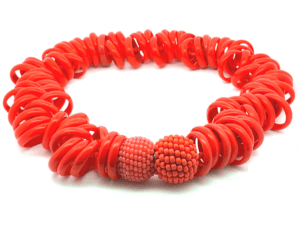Is it time to consider insuring, donating or dispersing your art jewelry collection – or any of your jewelry? A necessary part of such a process is obtaining an appraisal; before getting the appraisal, you need to find an appropriate appraiser.
A personal property appraisal for jewelry includes a document that identifies each piece of jewelry with sufficient clarity and detail (image, measurements, weight, marks, age) that if the item is lost, stolen or donated, there will be no doubt of its value or identity. The appraiser you select, besides having knowledge of jewelry (e.g. metals, gemstones, provenance, history, etc.) must be qualified to appraise each item.
National organizations such as The International Society of Appraisers, The National Association of Jewelry Appraisers and The American Association of Appraisers are just three organizations from which to select a qualified appraiser. Each organization teaches appraisal theory and administers qualifying examinations for appraisers. It is not enough to know values. It is not enough to sell such items on a daily basis. Creating an appraisal is a very specific task and the finished document serves a very specific purpose. For instance, if you are looking to donate jewelry for tax purposes, the appraisal will be scrutinized. You can be sure that a donation appraisal valued over $5000 will be examined by the Inland Revenue Service.
A caveat: Even though an appraiser may be qualified as a personal property appraiser, almost all appraisers have a specialty. When making an inquiry, specify that you need a jewelry appraiser.
Now to the questions you need answered.
One: For What Purpose Do I Need An Appraisal?
Appraisals are written for several different purposes and the values of each appraisal will differ, depending upon that purpose. When making an inquiry, be clear about what you need. The appraiser can assist you in determining the purpose. It is not unusual for someone to have more than a single purpose, such as insurance and liquidation, or donation and dispersal. Be clear about your needs or, if you are undecided or confused, share that information with your appraiser.
Purposes include: Insurance, Damage Claim, Estate Settlement, Liquidation, Divorce, Bankruptcy, Charitable Donation, Dispersal, Hypothetical (such as fire, where jewelry has been destroyed or jewelry is unavailable for some other reason).
The specific purpose of the appraisal will determine the value. For instance, an insurance value will likely be higher than a liquidation value. If you are in need of an appraisal for federal tax purposes, there is only one value: Fair Market Value (FMV). FMV is defined as a willing buyer and a willing seller with neither compelled to act and both having reasonable knowledge of the relevant facts.
Two: How Do I Find An Appraiser?
Check the organizations mentioned above. Once you have a name or names, do your research. Determine credentials, specializations, convenience (e.g. location near you) and experience. It is not inappropriate to request references from past clients.
Three: What Will It Cost?
Ask. Discuss the services you require and the number of pieces you need appraised.
Never say: ‘I just want a ballpark figure.’ You wouldn’t ask your doctor for a ballpark diagnosis. Your first conversation should include information about the amount of time necessary to accomplish the appraisal, the number of pieces you wish to have appraised and the approximate cost of the appraisal. On very large estates, it is not unusual for an appraiser to ask for an initial retainer.
If you are concerned about leaving your jewelry, ask the appraiser if you can be present while they undertake the appraisal.
Remember and anticipate that any appraised values may or may not be what you expect or wish them to be. It is not appropriate to suggest to the appraiser what values you expect, wish or need. If an appraiser acquiesces to your desires, it’s time to seek a different appraiser.
Fees are either hourly, per piece or a flat fee. On larger estates, such as divorce or bankruptcy, there may be an upfront retainer. The value of an item does not determine the fee. Ever.
Four: What Do I Do When I’m Worried About Leaving My jewelry?
The most common request related to ‘switching-stone’ stories is based on the fear that the stone you are having appraised will be replaced with a stone of less value. I have yet to meet a client who does not have this fear. Everyone, whether client or appraiser, has this concern. Most of the stone-switching stories are pure imagination, but it has undoubtedly happened. The concern is greatest with diamond jewelry.
If you leave diamond jewelry with the appraiser, request a ‘plot.’ Plotting refers to a process where the jewelry item is placed under the microscope and a drawing is made of the stone’s inclusions, chips or cut. Plotting protects both the client and the appraiser.
This is how we manage this process at Facèré: On a printed outline of the stone, the inclusions or other identifying characteristics are drawn. Next, we have our client look through the microscope. The client agrees to the drawing and initials the plot. Most plots are done at ten power. If, however, the customer is having difficulty seeing the inclusion or the chip, or the type of cut, we increase the power to thirty. Once we are satisfied that the client actually sees the identifying characteristics, we have them initial the drawing. When the item is returned, the microscope examination is repeated to confirm that the stone being returned is the same stone that was left. And once again, the client initials the sentence that states the item has been identified and returned.
Diamonds of a half-karat or larger are always plotted. Should the client be concerned about a diamond smaller than a half-karat, we will plot the stone. It is difficult to imagine anyone concerned about switching such a stone, but if there is unease, we will plot what is requested.
We also agree with the client on a value that the jewelry item will be insured for while it is in our care. This is not an appraisal. It is simply an amount that is comfortable for the client and comfortable for the gallery.
Five: Does the Appraiser Have to Actually Handle the items?
Yes, indeed. The appraiser needs the items in hand. There is an exception: The ‘hypothetical’ appraisal can be accomplished with photographs, drawings and detailed descriptions if the actual jewelry no longer exists or is unavailable. This is a ‘limiting condition’ and will be noted in the appraisal.
Six: Does Every Piece of Jewelry Need Appraising?
No. Often a client does not need a per piece appraisal. So how does one decide on a general or relative/approximate valuation?
At Facèré we offer offer a ‘sort.’ This often is necessary in the case of death when the family has boxes of jewelry ‘stuff.’ We tell our client to bring everything. We sort quickly and when we finish, the client knows which items need a full appraisal, which items will be given for ‘dress-up’ to the grandchildren, which items can be donated to a charity such as Goodwill or St Vincent de Paul and which items they might wish to sell for scrap. Sorting is a professional service. If you need such, ask what the charge will be. For this purpose we charge an hourly fee.
Seven: What Else?
Don’t forget! Once the appraisal is finished and the value has been determined, you need a copy for your insurance agent, or your accountant, or your lawyer. It has been known to happen that the appraisal, once finished, is stored in a box in the basement and never seen again. The best place to store your appraisal document is with your will and other important papers.
Eight: And Should I Wish to Sell?
Selling is a separate function. Appraisers do not purchase what they appraise. That is a conflict of interest and should make alarms go off.
Now, time to begin.




